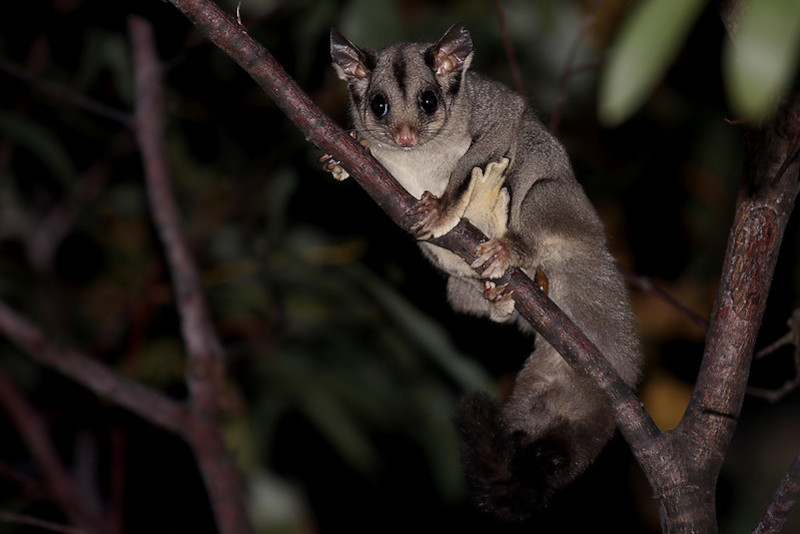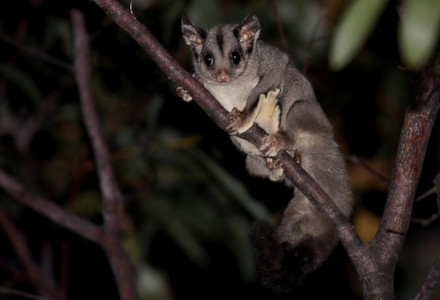
Photographer: patrickkavanagh
CC License: https://bit.ly/3yvkJAT
Sugar Glider Facts
- Firstly, the term Sugar Glider names a small and quite adorable species of flying marsupial. Despite a slight resemblance, it has no relationship to flying squirrels but actually remains a type of possum.
- Secondly, the common name for this remarkable animal actually derives from two factors. The first is its tendency to glide through the air, while the other remains its affinity for sugary foods during the winter.
- Despite a reduction of indigenous habitat, its numbers thankfully appear to be continuing to remain steady. For this reason, the IUCN has listed the Sugar Glider as a Species of Least Concern on its Red List.
- Further, these fabulous small creatures have proven themselves to be extremely resilient to change. That’s because, for the moment, the animal appears to be able to survive in small, isolated patches of forest.
Related Articles
Tree Kangaroo Bandicoot Quokka
Photographer: Tim Tim
Public Domain Image
Sugar Glider Physical Description
Perhaps most notably, the Sugar Glider has a thin, elongated body shape. This gives it a shape similar to that of a squirrel. This coincidental physical resemblance often leads to the common confusion many people experience.
Sexual Dimorphism also appears in this species, like many others. In its case, males typically grow slightly larger than females. Females average 12 in (30.5 cm) in body length. But males reach roughly 13 in (33 cm) in total size.
In addition, the tail grows relatively long and partially prehensile, like many possums, and the fur develops thick and soft. In color, individuals typically present a combination of blue-gray, yellow, and tan on the back and sides.
The natural coloring of the Sugar Glider also present a striking image. That’s because its underbelly typically has a cream color. Meanwhile, a large black stripe generally appears from the nose to midway down the length of the back.
Furthermore, the eyes also remain large and set far apart. In addition, a thin membrane extends from each front foot to each hind foot. When extended, this membrane allows the animal to glide from branch to branch.
- Kingdom: Animalia
- Phylum: Chordata
- Class: Mammalia
- Order: Diprodontia
- Family: Petauridae
- Genus: Petaurus
- Species: P. breviceps
Photographer: Ltshears
CC License: https://bit.ly/2VsGVNU
Sugar Glider Distribution, Habitat, and Ecology
While the awesome Sugar Glider evolved in a restricted habitat range, where that is comes as no surprise. Not surprisingly, it evolved as endemic to Australia and parts of Tasmania, New Guinea, and numerous islands in the region.
Also, most individuals typically inhabit regions at altitudes measuring up to 6,562 ft (2,000 m). Being highly adaptable, it most commonly appears in either temperate forests or rainforests. But it also sometimes appears in regions of scrub.
These arboreal creatures remain principally nocturnal in nature. They further seem to be seasonally-adapted omnivores. During the Spring and Summer, it feeds as an insectivore. During the winter, however, the Sugar Glider feeds on the gum and sap of various plants.
Its primary predators include snakes and owls. The marsupial also evolved as highly social creatures, commonly living in small groups or colonies. Reproduction occurs 1-2 times per year, depending on environmental conditions. A typical lifespan in the wild measures about 9 years.
Species Sharing Its Range
Thorny Dragon Western Underground Orchid Pesquet’s Parrot
Check out our other articles on 5 Fabulous European Mammals, Six-Spotted Fishing Spider, Blyde River Canyon, Amethyst Deceiver, Naked Mole Rat, Wood Frog, Snowy Owl

